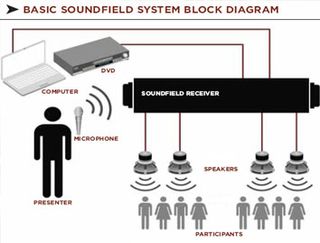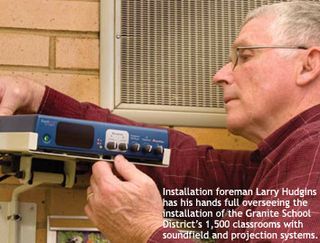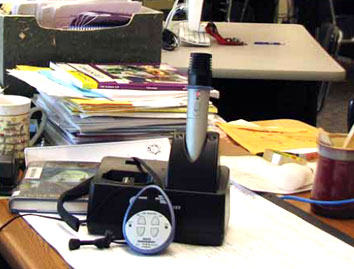Over the past few decades, school teachers have been embracing a number of electronic technologies for use in the classroom. Computers are now prevalent; overhead projectors are being replaced with dynamic teaching tools such as data projection, electronic whiteboards, and video media. But one key technology is just beginning to catch up to the others: audio amplification and reinforcement. The Americans with Disabilities Act (ADA) requires most public venues to provide hearing assistance when requested. Assistive listening devices have been in use for many years, but are typically provided only to people with hearing impairment. However, numerous studies indicate that audio reinforcement can benefit all students, not just the hearing impaired. It's pretty common for adults to think a classroom is a perfect listening environment, when in reality it's anything but that," says John Merline of Front Row, a company specializing in classroom audio products. "Children with completely normal hearing can have difficulty capturing what the teacher is saying because of noise in the classroom and distance from the teacher.
"Classrooms are noisy and full of distractions, and students are learning new material with brains that have not developed completely, so they can't easily fill in the gaps when they miss a word," says Merline. It's common knowledge that performance and behavior problems occur in the back of the classroom, and Merline says much of this is due to the fact that they just can't hear as well back there.
Another issue is the teacher's physical position relative to the students. "There's a feeling that the teacher stands at the front and looks at the class constantly to address the students, but that often isn't the case," says Jerry Hogerson, vice president of sales and marketing at TeachLogic. "With the use of electronic media and even with regular chalkboards, the teacher is looking at the board or screen much of the time, talking and pointing to the board, and not looking at the students." Hogerson says that reflected sound, such as speech bouncing off a chalkboard, can be much less intelligible than forwarddirected speech.
SOUNDFIELD SYSTEM

Improving the clarity of the teacher's speech throughout the classroom is highly desirable. Industry studies clearly show that sound reinforcement can give students better comprehension and retention in the classroom. Although a school may be tempted to use assistive listening devices for everyone in the back of the room, those devices aren't the most practical solution. A better choice, one that is readily available, is a soundfield system.
Russell Gentner, president of Listen Technologies Corporation, explains the difference between a soundfield and an assistive listening system: "An assistive listening system typically uses a microphone and portable transmitter worn by the instructor. Systems can be either RF (Radio Frequency), such as FM, or IR (infrared). The portable transmitter sends an RF or IR signal to portable receivers worn by hearingimpaired individuals. These individuals get direct sound in their ears via headphones, earbuds, or inductive neckloops, and those individuals can directly control volume, etc. with a remote control. A soundfield also uses a portable transmitter and a microphone worn by the instructor, and it can also be either RF or IR, but it sends its signal to a central receiver and then to several loudspeakers in the room. This effectively provides a sound reinforcement system, adding 3 to 6 dB of gain, which dramatically improves the signal-tonoise ratio in the room." See Figure 1: Basic Soundfield System Block Diagram.
Should you select RF or IR for your class? "RF systems were used for several years and are a good technology, but may not serve the purposes for students because of the large number of classrooms in a confined space," says Tom Dobson, vice president of sales and marketing at Audio Enhancement. The problem with RF systems is not in their quality, it's the potential for interference. An RF-based system works anywhere, but can be heard in locations outside the classroom and can be affected by other transmitting devices. An IR system does not interfere with systems in adjoining rooms, and does not receive interference from other systems.
In 1997, Audio Enhancement took out a patent on the use of IR in the classroom, and, in 1999, the company came to market with the first IR soundfield system. "This technical breakthrough was the true catalyst of the market that we have today; without it the use of sound in the classroom would still be relegated to a special education application, where limited numbers of systems can be used," Dobson says.
The main downside of infrared is that it is adversely affected by strong light sources. If you install an IR system, be sure to note how sunlight will enter the room during different times of the year, "and don't put the receiver on the ceiling between the projector and screen!" Hogerson says. "We've had service calls to fix a non-working IR system, only to find the receiver getting blasted with light from the projector."
The main components of a soundfield system are the teacher's microphone and transmitter, a receiver, an audio amplifier, and multiple loudspeakers - "a minimum of four is needed," says Hogerson - strategically placed around the room. The goal is to get consistent levels of audio no matter where a student is sitting in the room. Other multimedia products such as DVD players or computers are also connected to the audio amplifier. The best option for the teacher's microphone is a head-worn or neck-worn unit that keeps a microphone element next to the mouth at all times. This allows the teacher to move around the room and even face away from the class while still being heard.
Gentner says some hearing-impaired students may refuse to use a personal assistive listening system out of embarrassment or the notion of inconvenience, but gladly use a soundfield because it won't "mark" them as different from the other students. And everyone benefits, not just the hearing-impaired child," he says. Gentner notes that many soundfield systems also have the ability to work with assistive listening devices, so it isn't necessary to have two separate systems in the room to accommodate everyone.
There is a secondary - but equally important - benefit of soundfield systems: teachers' voices are spared from the strains of harsh daily use. "Teachers are among the most likely people to have a vocal problem sometime during their career - about 32 times more likely - due to the constant strain on their vocal cords," Front Row's Merline says. There is another subtle problem, he says: "The louder voices used in a non-reinforced classroom can actually be perceived as hostile by young students." When using reinforced audio, he says, a teacher no longer has to stress every word and can speak normally. In fact, they can now use their voices to enhance their teaching, with tones ranging from a whisper to forceful, and the teachers find that they are less tired at the end of the day.
Rachel Murphy, a teacher in Salt Lake City, agrees: "When my class starts getting out of control, all I have to do is turn on the microphone system and they settle down right away. The audio system seems to have a calming effect on the class, and it lets me use a regular voice instead of having to 'project' all the time."
PUTTING SOUNDFIELDS TO WORK
The Granite School District, based in Salt Lake County, UT, comprises some 3,000 classrooms. Utah schools have the highest pupil-to-teacher ratio in the country, and district officials were concerned about students' ability to hear the teacher as well as having access to modern technology. The district embarked on a large project in January 2008 to outfit its classrooms with soundfield systems and other AV technologies.

School officials plan to put a combination of audio amplification and projection in every classroom in the district, starting with the elementary schools. Such large-scale school projects require a consensus of opinion, according to Larry Hudgins, Granite School District's project foreman. "I have a committee of six people who do a walk-through when we first start a school project. We meet with the school, determine the classroom layouts, then our integrator and electrical team come in and get started on the installations. We are doing this at the rate of one to two schools per week."
Jim Henderson, director of instructional technology for the Granite district, says the current phase of the project - outfitting about 1,500 classrooms with soundfield systems and projection equipment - will cost about $4.7 million. "We are installing this equipment at the rate of about two schools per week," he says. Installation work by Phoenix, AZ-based AV systems provider Troxell Communications is mostly done in the evenings to avoid classroom interruption. "The studies we researched indicated that audio amplification is most effective in the younger grades, and the teachers were requesting it," says Henderson. "Once we complete the elementary schools, we will move on to the junior highs and high schools."
The Granite school district installations each include soundfield microphones and transmitters, two access points for receiving the signals, a ceilingmounted projector, four ceiling-mounted loudspeakers, and an audio amplifier. The teacher's computer is used as a source for the projector for DVDs, internet media, etc. "An interesting aspect of this project is that the teachers need to decide how the classroom is going to be oriented before we begin," Henderson notes. "Rather than being able to move the desks around and change the front of the room constantly, they have to be oriented in the same direction from here on."
Each classroom installation includes four ceiling-mounted loudspeakers to provide uniform audio coverage and a ceiling-mounted Hitachi projector. Receivers for the Front Row soundfield system are placed in strategic locations to pick up the teacher's microphone as he/she moves around the room. Henderson also says many of the installations require electrical retrofitting to accommodate the new technologies.
"Classroom amplification makes an academic difference," says Audio Enhancement's Dobson. "It reduces or eliminates the effects of noise, distance, and reverberation. All students can hear the teacher and each other all the time. If we are able to communicate, we are more able to learn. We need to do all we can to make certain that every child has a maximum opportunity to hear."
Elaine Jones operates a PR agency specializing in the AV industry and is based in Salt Lake City, UT. She can be reached atelaine@ejonespr.com.










